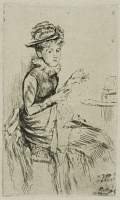Etchings Institutions search term: wunderlich
Tatting | ||
| Number: | 130 | |
| Date: | 1874 | |
| Medium: | etching | |
| Size: | 126 x 74 mm | |
| Signed: | no | |
| Inscribed: | no | |
| Set/Publication: | Fine Art Society | |
| No. of States: | 1 | |
| Known impressions: | 10 | |
| Catalogues: | K.112; M.111; W.98 | |
| Impressions taken from this plate (10) | ||
TECHNIQUE
The main work is in etching, the lines being emphasized by retroussage. Her right arm was original drawn lower, in two different positions, and her left hand has likewise been altered. There are numerous outlines defining the torso and skirt, with the lines of 'tatting' conflicting with the outline of the skirt. Most of the drawing is done with patches of shading, some widely spaced. Faint, somewhat cursory shading is seen in the background, and acid droplets and foul biting are scattered to right of the figure.
PRINTING
It was published in 1880 by Dowdeswell & Dowdeswell, in a proposed edition of 25 numbered impressions. The main edition was printed by Frederick Goulding (1842-1909), in 1880, when Whistler was in Venice and could have had no part in printing. Some of Goulding's impressions were printed in dark brown ink with some retroussage to enhance the drypoint, and some were signed by Goulding ( ). 15 It is probable that numbers written in graphite pencil in the margin of some impressions refer to this edition, including '2' (
). 15 It is probable that numbers written in graphite pencil in the margin of some impressions refer to this edition, including '2' ( ); '8' or '16' (
); '8' or '16' ( ); and '11' (
); and '11' ( ).
).
 ). 15 It is probable that numbers written in graphite pencil in the margin of some impressions refer to this edition, including '2' (
). 15 It is probable that numbers written in graphite pencil in the margin of some impressions refer to this edition, including '2' ( ); '8' or '16' (
); '8' or '16' ( ); and '11' (
); and '11' ( ).
).15: There is no mention of Tatting in the principal book on Goulding: Hardie 1910 .
